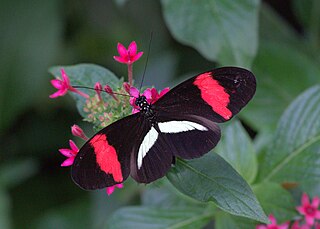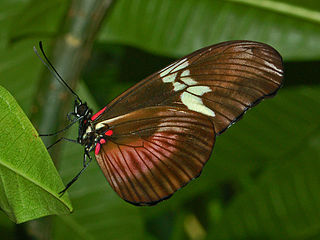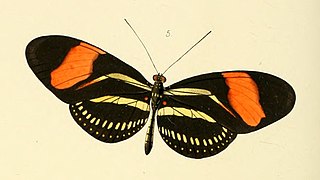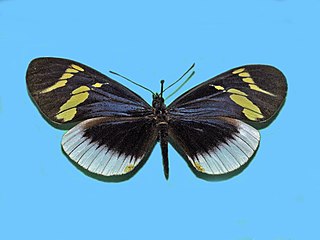
Heliconius charithonia, the zebra longwing or zebra heliconian, is a species of butterfly belonging to the subfamily Heliconiinae of the family Nymphalidae. It was first described by Carl Linnaeus in his 1767 12th edition of Systema Naturae. The boldly striped black and white wing pattern is aposematic, warning off predators. It is the state butterfly of Florida.

Heliconius erato, or the red postman, is one of about 40 neotropical species of butterfly belonging to the genus Heliconius. It is also commonly known as the small postman, the red passion flower butterfly, or the crimson-patched longwing. It was described by Carl Linnaeus in his 1758 10th edition of Systema Naturae.

Heliconius cydno, the cydno longwing, is a nymphalid butterfly that ranges from Mexico to northern South America. It is typically found in the forest understory and deposits its eggs on a variety of plants of the genus Passiflora. It is a member of the Heliconiinae subfamily of Central and South America, and it is the only heliconiine that can be considered oligophagous. H. cydno is also characterized by hybridization and Müllerian mimicry. Wing coloration plays a key role in mate choice and has further implications in regards to sympatric speciation. Macrolide scent gland extracts and wing-clicking behavior further characterize this species.

Heliconius comprises a colorful and widespread genus of brush-footed butterflies commonly known as the longwings or heliconians. This genus is distributed throughout the tropical and subtropical regions of the New World, from South America as far north as the southern United States. The larvae of these butterflies eat passion flower vines (Passifloraceae). Adults exhibit bright wing color patterns which signal their distastefulness to potential predators.

The Talamancan montane forests ecoregion, in the tropical moist broadleaf forest biome, are in montane Costa Rica and western Panama in Central America.
Heliconius nattereri is a species of butterfly in the family Nymphalidae. It is endemic to the Atlantic forest of Brazil.

Heliconius ismenius, the Ismenius tiger or tiger heliconian, is a butterfly of the family Nymphalidae found in Central America and northern South America. They are abundant as far south as Ecuador and Venezuela and as far north as southern Mexico, Guatemala and Belize. H. ismenius are more commonly called the tiger-striped long wing butterfly. H. ismenius's nickname is derived from its long wing structure as well as the beautiful burnt orange and black stripes. Pierre André Latreille, a French zoologist, described Heliconius ismenius in 1817. H. ismenius resembles a number of other butterflies, an example of Müllerian mimicry.

Heliconius doris, the Doris longwing or Doris is a species of butterfly in the family Nymphalidae. It is known for being a polymorphic species which participates in various Müllerian mimicry rings throughout Central America and the Amazon rainforest. It is a species of special interest in biological science for the genetic basis and role of polymorphism (biology) in ecology and evolution.

Heliconius hecalesia, the five-spotted longwing, is a species of butterfly of the family Nymphalidae. It is found from Central America to Venezuela and Ecuador.

Heliconius hortense, the Mexican longwing, Mexican heliconian or mountain longwing, is a heliconiid butterfly.

Heliconius hermathena, the Hermathena longwing, is a species of butterfly of the family Nymphalidae. It is endemic to white sand areas of the Amazon basin. Heliconius hermathena is a sand forest nymphalid butterfly and they are typically lowland tropical forest organisms although a handful subspecies can be found in southeastern Brazil and part of the dry forests of Peru.
Heliconius hecuba, the Hecuba longwing, is a species of butterfly of the family Nymphalidae. It lives at altitudes ranging from 1000 to 2400 m in cloud forests in the northern Andes from Colombia to Ecuador.

Heliconius antiochus, the Antiochus longwing, is a butterfly of the family Nymphalidae. It was described by Carl Linnaeus in 1767. It is found from Panama to the Amazon region. The habitat consists of riparian forests.

Heliconius demeter, the Demeter longwing, is a butterfly of the family Nymphalidae. It was described by Otto Staudinger in 1897. It is found in the Northern and Eastern part of the Amazon basin, from Guyana to Northern Brazil and Peru. The habitat consists of sandy rainforests.

Heliconius ethilla, the ethilia longwing, is a butterfly of the family Nymphalidae. It was described by Jean-Baptiste Godart in 1819. It is found from Panama to southern Brazil. The habitat consists of marginal forests.

Heliconius telesiphe, the telesiphe longwing, is a butterfly of the family Nymphalidae. It was described by Edward Doubleday in 1847. It is found at mid-elevations in the Andes. Its habitat is cloud forests.

Heliconius sapho, the Sapho longwing, is a butterfly of the family Nymphalidae. It was described by Dru Drury in 1782. It is found from Mexico southward to Ecuador.
The Spirogyra Butterfly Farm Park Garden,, located in San Francisco de Goicoechea, on the edge of Rio Torres, north of Zoológico Simón Bolívar, in Barrio Amon, Carmen District, San José, Costa Rica, is a butterfly house that houses from 50 to 60 different species of live butterflies from around the country in a climate-controlled, glass-enclosed habitat.

Heliconius eleuchia, the white-edged longwing, is a species of Heliconius butterfly described by William Chapman Hewitson in 1853.

Heliconius eratosignis, the eratosignis longwing, is a butterfly of the family Nymphalidae. It was described by James John Joicey and George Talbot in 1925. It is found in the south-western Amazon basin, from Brazil to Peru and Bolivia. The habitat consists of sandy rainforests.





